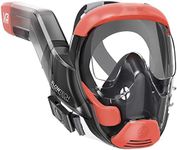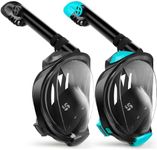Buying Guide for the Best Full Face Snorkel Masks
Choosing a full-face snorkel mask can make your underwater adventures more comfortable and enjoyable, especially if you’re new to snorkeling. These masks cover your entire face, allowing you to breathe naturally through your nose and mouth while keeping water out. To find the best fit for your needs, it’s important to understand the key features and how they impact your experience. By focusing on the right specifications, you can ensure safety, comfort, and clear vision during your snorkeling trips.Fit and SizingFit and sizing refer to how well the mask seals around your face. A good fit is crucial because it prevents water from leaking in and ensures you can breathe comfortably. Masks usually come in different sizes, often based on the distance from the bridge of your nose to your chin. If the mask is too small, it may feel tight and uncomfortable; if it’s too large, it may not seal properly. To pick the right size, measure your face as recommended by the manufacturer and choose the size that matches your measurements. Always try the mask on if possible to check for a snug, leak-free fit.
Breathing SystemThe breathing system in a full-face snorkel mask is designed to separate inhaled and exhaled air, reducing fogging and making breathing easier. Some masks have advanced airflow systems that keep fresh air circulating and direct exhaled air away from the viewing area. Simpler systems may not separate the air as well, which can lead to fogging or discomfort. If you plan to snorkel for longer periods or want the clearest view, look for a mask with a well-designed airflow system. Your comfort and safety depend on how easily you can breathe, so consider your own breathing preferences and needs.
Lens and Field of ViewThe lens is the clear part of the mask that lets you see underwater, and the field of view describes how much you can see from side to side. Full-face masks usually offer a wide, panoramic view, but the quality and size of the lens can vary. Some lenses are flat, while others are curved for a broader view. If you want to enjoy the scenery and spot more marine life, choose a mask with a wide, clear lens. If you’re prone to feeling claustrophobic, a larger field of view can help you feel more comfortable.
Anti-Fog FeaturesAnti-fog features help keep the lens clear so you can see underwater without having to stop and clean the mask. Some masks use special coatings on the lens, while others rely on airflow systems to prevent fogging. If you plan to snorkel in warm or humid conditions, or if you want to avoid interruptions, look for a mask with reliable anti-fog technology. Your choice should depend on how long you plan to snorkel and how important a clear view is to you.
Dry-Top SnorkelA dry-top snorkel is a feature that prevents water from entering the breathing tube when you dive below the surface or when waves splash over you. This is important for safety and comfort, as it helps you avoid swallowing water. Some masks have more advanced dry-top systems that seal quickly and effectively, while others may only offer basic protection. If you’re a beginner or plan to snorkel in choppy water, a reliable dry-top snorkel is a must. Consider your swimming skills and the conditions you’ll be snorkeling in when making your choice.
Strap Design and ComfortThe strap design affects how securely and comfortably the mask stays on your head. Some masks use elastic fabric straps, while others use silicone or adjustable buckles. A comfortable strap will keep the mask in place without pulling your hair or causing pressure points. If you have long hair or plan to wear the mask for extended periods, look for a strap that’s easy to adjust and gentle on your head. Your comfort during snorkeling depends a lot on this feature.
















